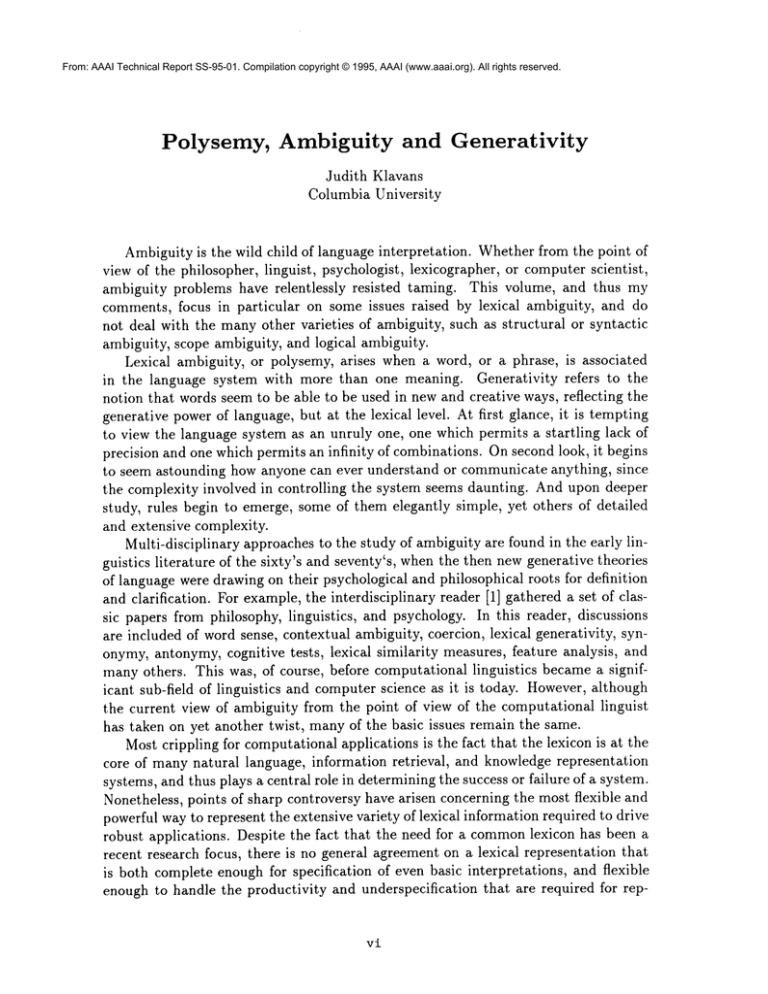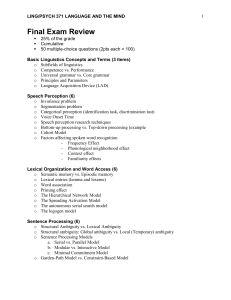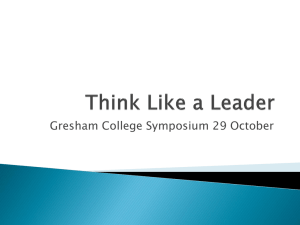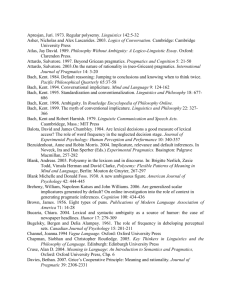Document 13778677
advertisement

From: AAAI Technical Report SS-95-01. Compilation copyright © 1995, AAAI (www.aaai.org). All rights reserved. Polysemy, Ambiguity and Generativity Judith Klavans Columbia University Ambiguityis the wild child of language interpretation. Whetherfrom the point of view of the philosopher, linguist, psychologist, lexicographer, or computer scientist, ambiguity problems have relentlessly resisted taming. This volume, and thus my comments, focus in particular on some issues raised by lexical ambiguity, and do not deal with the manyother varieties of ambiguity, such as structural or syntactic ambiguity, scope ambiguity, and logical ambiguity. Lexical ambiguity, or polysemy, arises when a word, or a phrase, is associated in the language system with more than one meaning. Generativity refers to the notion that words seem to be able to be used in newand creative ways, reflecting the generative powerof language, but at the lexical level. At first glance, it is tempting to view the language system as an unruly one, one which permits a startling lack of precision and one which permits an infinity of combinations. Onsecond look, it begins to seem astounding howanyone can ever understand or communicateanything, since the complexity involved in controlling the system seems daunting. Andupon deeper study, rules begin to emerge, some of them elegantly simple, yet others of detailed and extensive complexity. Multi-disciplinary approaches to the study of ambiguity are found in the early linguistics literature of the sixty’s and seventy’s, whenthe then newgenerative theories of language were drawing on their psychological and philosophical roots for definition and clarification. For example,the interdisciplinary reader [1] gathered a set of classic papers from philosophy, linguistics, and psychology. In this reader, discussions are included of wordsense, contextual ambiguity, coercion, lexical generativity, synonymy,antonymy, cognitive tests, lexical similarity measures, feature analysis, and manyothers. This was, of course, before computational linguistics becamea significant sub-field of linguistics and computer science as it is today. However,although the current view of ambiguity from the point of view of the computational linguist has taken on yet another twist, manyof the basic issues remain the same. Mostcrippling for computationalapplications is the fact that the lexicon is at the core of manynatural language, information retrieval, and knowledge representation systems, and thus plays a central role in determining the success or failure of a system. Nonetheless, points of sharp controversy have arisen concerning the most flexible and powerful wayto represent the extensive variety of lexical information required to drive robust applications. Despite the fact that the need for a commonlexicon has been a recent research focus, there is no general agreement on a lexical representation that is both complete enough for specification of even basic interpretations, and flexible enough to handle the productivity and underspecification that are required for rep- v± resenting lexical semantics. Ways to determine the optimal representation of lexical knowledge needed for flexible broad-coverage lexicons, as well the acquisition of that knowledge, are at the core of lexical semantic research, and thus the core of this volume. These papers discuss some of the problematic issues of lexical representation, and ways to solve difficult and complex questions. The purpose of the Workshop Proceedings from the AAAI symposium on the "Representation and Acquisition of Lexical Knowledge: Polysemy, Ambiguity, and Generativity" is to address the step in the process of coping with ambiguity which involves the transition from the descriptive to the explanatory. The goal is to gather together a multi-disciplinary group and to bring together various perspectives. Although the context in which these papers are gathered is a computationally oriented one, several of the articles deal with issues more purely linguistic or psychological, but which have computational impact. A few of the papers deal with implementations, spelling out the realities resulting from theoretical studies of ambiguity. References 1971. Semantics: An interdisci[1] Steinberg, Danny D. and Leon A. Jakobivits. plinary Reader in Philosophy, Linguistics, and Psychology. Cambridge University Press: Cambridge, England. vii








